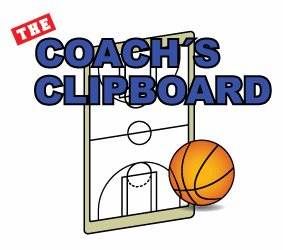Basketball Drills - Motion Offense Drills
By Dr. James Gels, From the Coach’s Clipboard Basketball Playbook"Helping coaches coach better..."
First read "Motion Offense". This article features break-down drills for teaching motion offense. Some of these drills are for guards and some are for post players. You might work with perimeter players at one basket, while on the other end, your assistant works with post players, or vice-versa. Many of these drills are applicable to any motion offense - 3out-2in, 4out-1in, 5out, etc. and help teach players how to "play the game".
After running some of these drills, play 4-on-4 or 5-on-5 half-court to reinforce things. Make the 4-on-4 and 5-on-5 drills competitive with losers doing push-ups. In all of these drills, we stress that our perimeter players get into triple-threat position when receiving a pass on the outside.
V-Cut Drill
Teach your perimeter players to V-cut, replace themselves, and receive the pass. Make sure they catch the ball in triple threat position. Use groups of three, and start with no defense, or token defense (no deny). The players reverse the ball around several times. Then you yell "Go!", and anything goes with the offense attempting a quick score, using a dribble move, a cut and pass, screen, back-cut, etc.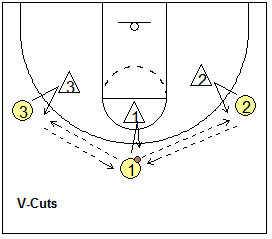
V-Cut, Back-Cut Drill
Next, teach the back-cut, which is used when the defender over-plays, or denies the pass. Have your X2 defender deny the pass, and teach O2 to recognize this situation and make the back-cut for a pass from O1. Initially, use token defense, and then go 2-on-2 with live defense. The O2 offensive player must learn to read the defender, and learn when to v-cut, and when to back-cut.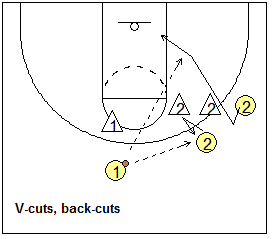
Point-Guard Give 'n Go Drill
Use the 2-on-2 setup. The X2 defender allows the pass from O1 to O2. O1 fakes left, and makes the basket-cut looking for the return pass from O2. Have the X1 defender play token defense at first. Then go live. If the X1 defender over-plays the passing lane, the point guard can fake the cut and pop back out for the pass and outside shot. If the X2 defender cheats toward the passing lane, then O2 can fake the pass, and dribble-penetrate to the hoop.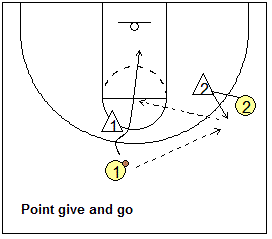
Dribble-Entry, Rotate Drill
If O1 is not able to pass to the wing, he/she may dribble there and replace the wing. The wing player must recognize this, and back-cut to the hoop. He/she cuts all the way through to the opposite wing. The opposite wing replaces O1 at the point. Rotate around several times (go left also) and then yell "Go!", and finish the set with a pass to a cutter for the lay-up or shot.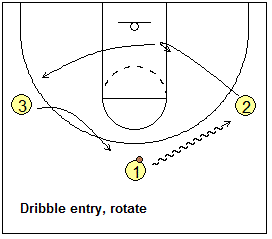
Dribble-At, Back-cut Drill
We have a rule for perimeter players that whenever a teammate is dribbling at you, you must back-cut out of the area. The first part of this drill is similar to the dribble-entry drill above. O1 dribbles at either wing. The wing back-cuts out to the opposite wing. If open, O1 can pass to the cutter.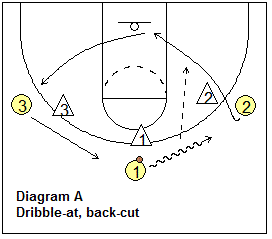
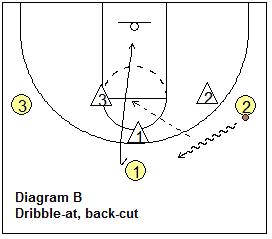
Otherwise O1 passes back out on top to O3 and O3 then dribbles to either wing to continue the drill. In diagram B, the wing player dribbles toward the top, and here O1 fakes a cut outside and then back-cuts. O1 either receives the pass on the back-cut and scores, or moves back out to the vacated wing spot.
2-on-2 take the Seam
We want our guards to be aggressive and attack the seams between the defenders, and learn when to "go" and when to kick the pass back outside. Start with the ball at the top and O1 tries to attack the seam between the two defenders. When the X2 defender drops to give help against the dribble-penetration, O2 slides toward the corner.O1 has the option of attacking for the lay-up, or kicking the pass out to O2 in the corner. If O2 gets the ball in the corner, he/she has the options of (1) shooting the 3-point shot, (2) a shot-fake and one-dribble jump shot, or (3) attacking the seam for a lay-up.
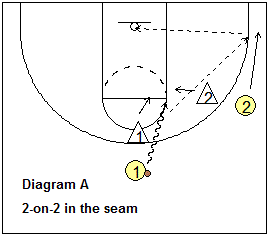
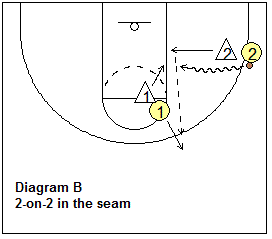
When attacking the seam, O1 should already have sprinted back out to the top, and may receive the pass from O2 if the defenders hedge and stop the drive. Now O1 has the same three options.
In this drill, we don't allow the offense to attack the baseline or attack outside the seam. Notice that this is also a good defensive drill for learning to give help and recover against dribble-penetration. We run this drill on both sides of the court so that our point guards get proficient at attacking either the right or the left seam.
Feed the Post and Slide Drill
We don't want our perimeter players just standing still. When our wing players (O2 and O3) feed the low post, we want them to slide to the corner. Oftentimes, the wing defender will momentarily drop down toward the post or turns his/her head and for a moment loses sight of our wing.We have the wing slide to the corner as this is an easy pass back out of the post and is often open for the 3-point shot from the corner. If the ball is passed from the low post back out to the point, then our wing must slide back up.
In diagram K, we have our wings get in triple-treat, curl bounce pass to the low post, and then slide to the corner. Our post passes back out to the corner and the wing shoots the 3-pointer from the corner, gets the rebound and goes to the opposite side. We run this drill on both sides.
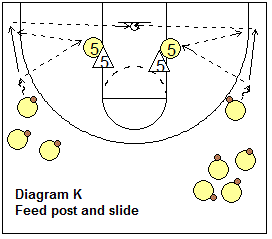
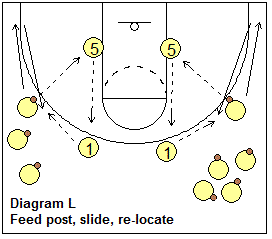
In diagram L, the wing again curl-bounce passes into the post and slides to the corner. Now the ball is passed back out on top to O1 and the wing slides back up, gets the pass from O1 and shoots the 3-pointer, rebounds and goes to the opposite line. Also see Feed the Low Post Drills.
Pass to Wing, Feed the Post Drill
Again, use the 2-on-2 setup with a post and wing offense and defense. O1 has the ball and passes to O2, and O2 bounce-passes into the post. We run this drill live so O2 must make a V-cut and get open for the pass from O1. O4 must post up inside while the defense tries to deny the pass inside. O2 may have to make a one-dribble adjustment to one side or the other to open a passing lane.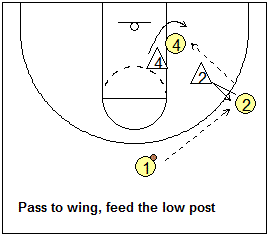
But first we want O2 to catch ball in triple-threat position and look into the post before putting the ball on the floor. We want O4 to post up aggressively and call for the ball. O4 makes a post move and finishes strong. This is also a good chance to work on boxing-out and rebounding - finish the drill! Rotate players after two possessions.
On-Ball Screen and Roll Drill
Use the 2-on-2 setup. O1 has the ball. O2 comes from his wing and ball-screens for O1. O1 dribbles around the screen to the hoop. O2 seals the X1 defender and rolls to the hoop. For correct screening techniques see "Setting and Using Screens".Also reverse the rolls. O1 passes to O2 on the wing, follows the pass and ball-screens for O2. O2 dribbles around the screen to the hoop, while O1 seals and rolls (or pops to the arc) after the screen.
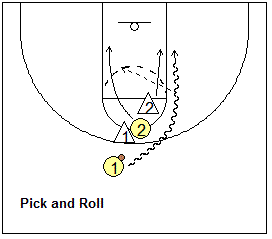
Screen Away Drill
Teach all your players correct screening techniques with this drill. Use three lines. O1 passes to O2, and "screens away" for O3 on the opposite wing (use a coach or manager as a token defender). O3 rubs off the screen and cuts to the hoop. Make sure that O3 waits for the screen to arrive, and uses it correctly. Make sure that O1 sets the correct angle on the screen.Also, make sure that O1 seals the defender, and then rolls to the hoop after O3 cuts around the screen. O2 passes to either cutter. Although not shown in the diagram, have O2 make a v-cut to receive the ball… again reinforcing that there is no standing still to receive a pass.
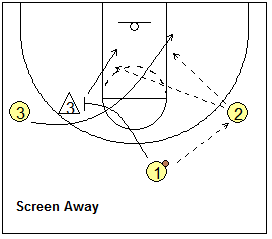
Down-screen Curl Drill
Teach your wings how to down-screen for the low post. The low post player curls around the screen for the pass and jump shot. Work both sides of the floor. Start with the X5 defender playing token defense, and progress to live defense.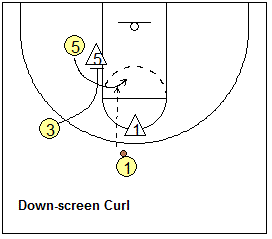
Back-screen Drill
Teach the low post players how to back-screen for the wing. The wing cuts behind the screen for the pass from O1. Show token defense at first, and have the X5 defender let O3 cut to the hoop for the pass and lay-up.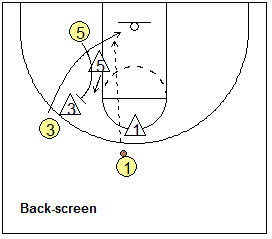
Back-Screen Pin
In this case, have the X5 defender switch on the back-screen and pick up the cutter O3. O3 reads this and moves out to the opposite short corner (for spacing). O5 who has screened the X3 defender, "pins" the defender, gaining inside position, and rolls to the hoop for the pass and lay-up. Again, start with token defense.Then progress to live defense allowing the defense to either fight through the screen, or switch. In either case, the offense must learn to read the defense - if the switch is made, use the back-screen pin.
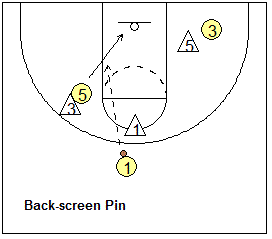
Feed the Low Post, Defender Behind Drill
Teach wing players to pass to the low post when the defender is playing behind. You can also place a defender on the wing player, so the wing has to "step-around" to make the pass. O4 gets wide with arms out to receive the ball. Once the pass is made, the opposite post cuts to the high post, to allow spacing for O4 to make a post move on the defender.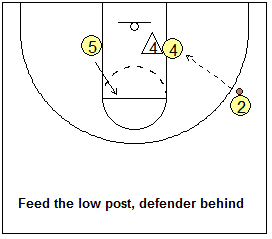
Defender Fronting the Low Post Drill
Now the low post is dead-fronted. Teach O5 to read this, and flash to the ball-side high post position for the pass from O2. O4 "pins", or seals, the defender and gets inside position for the pass from O5. Have all post players take turns, to learn to recognize this situation.If O4 is taller than the defender, the other option here is for O4 to pin the defender and "step-off" toward the hoop with a high hand for the high lob pass from O2 to O4.
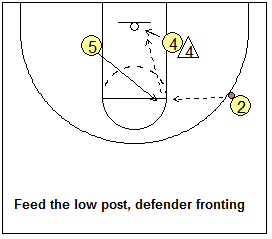
Posts 2-on-2 Drill
Use three perimeter players to rotate the ball (you can have them v-cut as in drill #1 above). The two offensive post players learn to work together, reading the defense, and work on screening for each other. When they receive the ball in the low post, let them make a post move on their defender. Use token defense at first, and progress to live defense.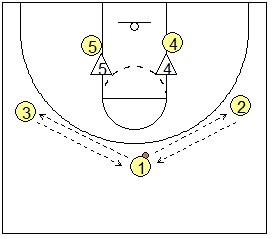
Post Players:
Your post players must learn how to screen for each other, and how to "pin" the defender after the screen, for inside position. This is important for getting easy, inside baskets. See the diagram below. If the ball-side post player cannot get open for the pass, he can screen away for the opposite post player, who cuts to the ball.If he does not receive the pass, or if the defense switches on the screen, he moves out to the short corner (for spacing). Now the screener should have inside position if he correctly pinned his defender. Incorporate these concepts in the "Posts 2-on-2 Drill" above.
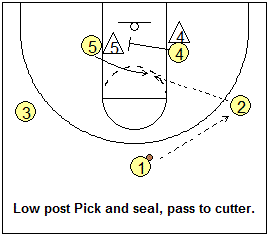
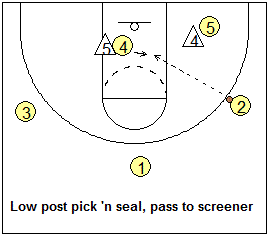
3-on-3 Half-Court Passing Drill (Bennett Drill)
Bad passing, turnovers a problem? Use this drill. Playing in the half-court, teams go 3-on-3. The offense must make 10 passes without losing the ball, or making a turnover (double-dribble, traveling, etc).Offensive players must pass, cut, dribble, screen, move, maintain spacing, etc. The offense does not shoot or attempt to score, but maintains control of the ball for 10 passes. Rotate offense to defense. If the offense completes 10 passes, they don't have to play defense that rotation.
This drill will help teams prone to turnovers and bad-passing. Use this drill every other practice and your team should see it's turnovers/game decrease.
Be innovative! Create your own drills to help teach the "motion offense". Rather than a lot of set plays, teach your players how to fake and cut, screen, pass, go backdoor, feed both the low and high posts, etc.
Scrimmage type drills
Go either 4-on-4 or 5-on-5 and make losers do push-ups. Make sure perimeter players are getting into triple-threat. They should execute the cuts and screens outlined above. You can set some rules. For example, if you want to stress screening, then no-one is allowed to shoot until at least two screens have been made - you count them out loud from the sideline.Another example - they are not allowed to shoot until the ball has gotten into the low post at least once, and then into the high post another time. Another time, the rule is no dribbling - only passing. The only dribble permitted is a one or two bounce dribble inside for the lay-up. Any unnecessary dribbling on the perimeter is a turnover.
This is fun for players. Keep score, alternate possessions, and make both teams play under the same offensive rules. The players enjoy this and instead of learning set plays, they will start learning basic motion offense and how to "play the game".
Related pages:
- Post Player Breakdown Drills
- How to Become a Good Post Player
- 3-2 Hi-Lo motion options
- Guard Breakdown Shooting Drills
- Perimeter Guard Moves
